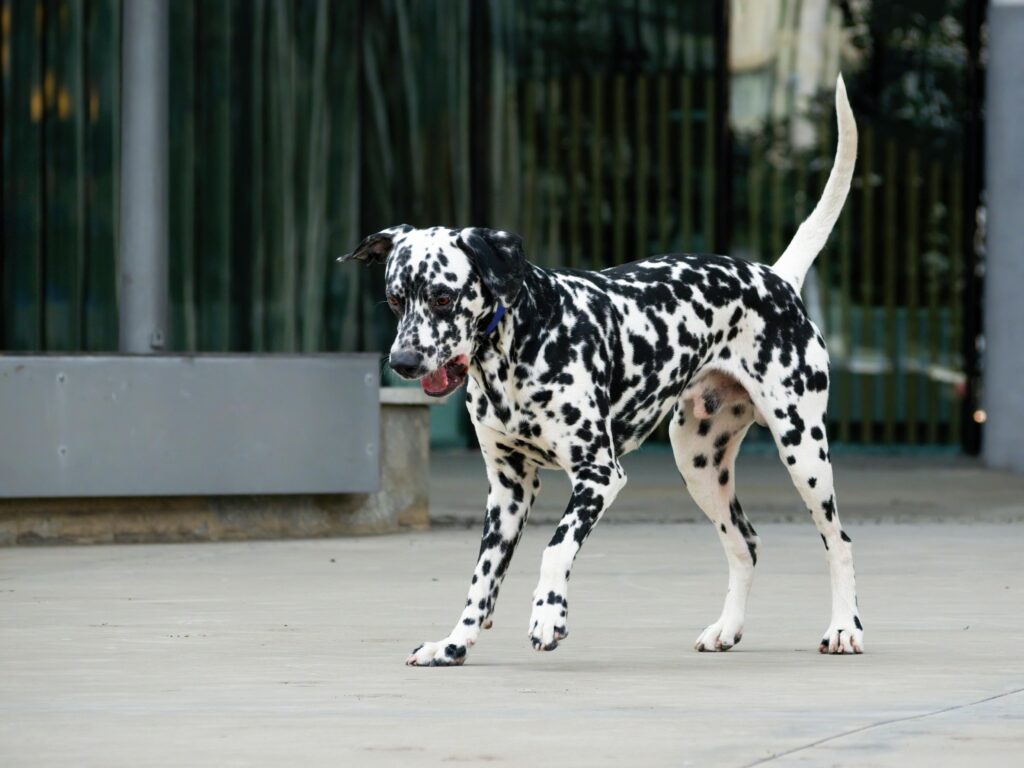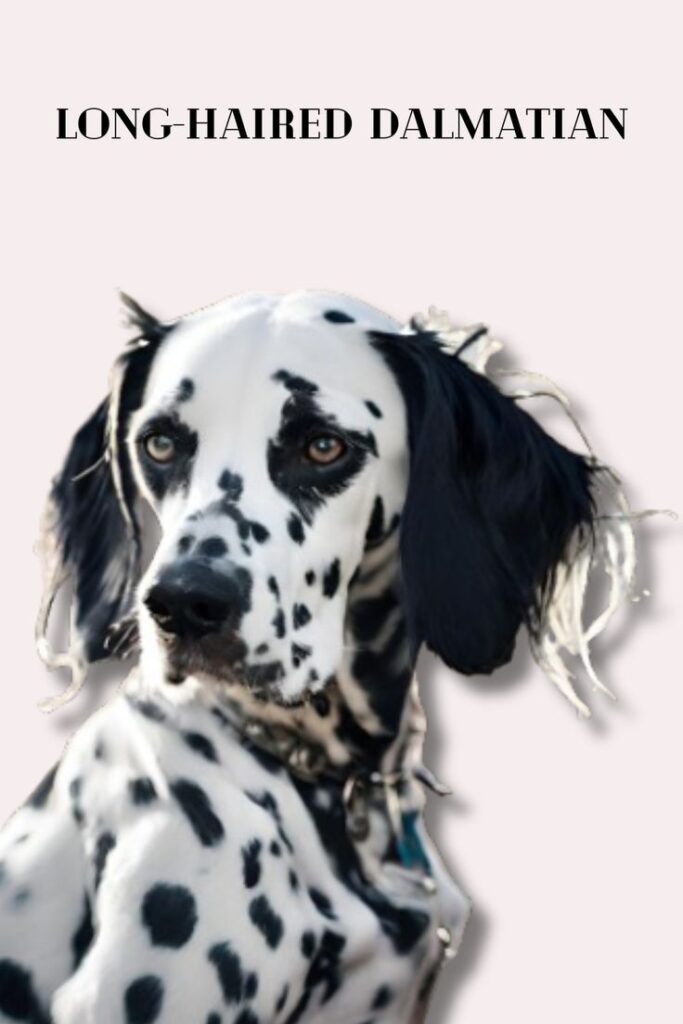Introduction
Welcoming you to the enchanting world of the Long-Haired Dalmatian, a breed that adds a unique twist to the classic Dalmatian look. In this comprehensive guide, we’ll delve into the origin, temperament, appearance, grooming needs, health considerations, and some fun facts about these captivating canines.
Join us on this journey to discover why Long-Haired Dalmatians are gaining popularity and whether they might be the perfect addition to your family.

Origin and History of the Long-Haired Dalmatian
The Dalmatian is a distinctive breed with a rich history that can be traced back centuries. Believed to have originated in the region of Dalmatia, which is part of modern-day Croatia, Dalmatians gained widespread recognition in the 18th century, particularly in England. They were often associated with horse-drawn carriages, serving as carriage dogs and guard dogs.
Dalmatians became popularized through their roles in firehouses, where they were used to clear the way for fire trucks. Their striking black or liver spots on a white coat, paired with their elegant and athletic build, contributed to their popularity. Today, Dalmatians are known for their unique appearance and have been featured in various forms of media, including books, movies, and as mascots for fire departments, further solidifying their place in cultural history.
What is a Long-Haired Dalmatian?
Diving into the specifics, a Long-Haired Dalmatian is essentially a Dalmatian with a longer, softer coat, setting it apart from its short-haired counterparts. This breed showcases the iconic Dalmatian spots on a velvety canvas, creating a stunning visual appeal. But are these long-coat Dalmatians rare?
Are Long Coat Dalmatians Rare?
While the traditional short-haired Dalmatians are more common, the long-haired variety is considered rarer. This uniqueness adds to their allure, making them a coveted choice for dog enthusiasts seeking something out of the ordinary.
Temperament and Personality of a Long-Haired Dalmatian
Moving beyond their appearance, Long-Haired Dalmatians are known for their distinctive personalities. These dogs are recognized for their intelligence, agility, and affectionate nature. However, like any breed, understanding their temperament is crucial for a harmonious relationship.
- Energetic and Playful:
- Dalmatians are a high-energy breed. They are known for their playful nature and can be quite active. Regular exercise and engaging activities are important for their well-being.
- Intelligent:
- Dalmatians are intelligent dogs and often respond well to training. Mental stimulation, along with physical exercise, is crucial for keeping them happy.
- Social:
- Dalmatians are social dogs that enjoy the company of their human family. They can form strong bonds with their owners and may seek attention and affection.
- Alert:
- Dalmatians have a natural alertness and may act as good watchdogs. They can be protective of their home and family.
- Independent Streak:
- Some Dalmatians can exhibit independence, which may translate to stubbornness. Consistent training and positive reinforcement are important.
- Good with Children:
- Dalmatians are often good with children. However, early socialization and supervision are crucial to ensure positive interactions.
- Affectionate:
- Many Dalmatians are affectionate dogs that enjoy spending time with their owners. They may seek cuddles and attention.
It’s important to note that individual dogs may vary in temperament, and factors such as early socialization, training, and environment play a significant role in shaping a dog’s behavior
How Much Exercise Do Long-Coat Dalmatians Need?
Long-haired Dalmatians share the energetic traits of their short-haired counterparts. Regular exercise is essential to keep them mentally stimulated and physically fit. Whether it’s a brisk walk, a game of fetch, or agility training, these activities cater to their energetic disposition.
Dalmatians are an athletic and active breed that benefits from both physical and mental stimulation. The amount of exercise needed can vary based on factors such as age, individual energy levels, and overall health. As a general guideline, Dalmatians often require at least 30 to 60 minutes of vigorous exercise daily.
Exercise can include activities such as brisk walks, jogging, play sessions, and interactive games. Mental stimulation, such as obedience training or puzzle toys, is also essential to keep their intelligent minds engaged.
It’s important to note that inadequate exercise and mental stimulation can lead to boredom and potentially result in undesirable behaviors. Additionally, Dalmatians may have a predisposition to certain health issues, so regular exercise contributes to their overall well-being.
Always consider the individual needs of your dog and consult with your veterinarian for personalized recommendations
Are Long-Haired Dalmatians Aggressive?
Contrary to misconceptions, Long-Haired Dalmatians are not inherently aggressive. Their temperament is shaped by factors such as socialization, training, and individual personality. Proper training and a nurturing environment can help mold them into well-behaved and friendly companions.

Appearance of Long-Haired Dalmatian
One cannot help but be captivated by the striking appearance of Long-Haired Dalmatians. Let’s explore their size, weight, and coloration to better understand what makes them so visually appealing.
The Dalmatian is a distinctive and easily recognizable breed known for its unique coat pattern of black or liver spots on a white background. Here are some key features of the Dalmatian’s appearance:
- Coat:
- Dalmatians have a short, dense, and sleek coat. The coat is fine and close-fitting to the body.
- Coloration:
- The coat color is white with well-defined spots that can be either black or liver (brown). The spots are round and evenly distributed over the body.
- Eye Color:
- Dalmatians typically have round, dark eyes. The eye color should harmonize with the coat color; black-spotted Dalmatians usually have dark eyes, while liver-spotted Dalmatians may have amber eyes.
- Ears:
- Dalmatians have medium-sized, set-back ears that are rounded at the tips. The ears should blend well with the head and be carried close to it.
- Tail:
- The tail of a Dalmatian is moderately long, reaching to the hock. It is carried with a slight upward curve but should not be curled over the back.
- Build:
- Dalmatians are well-balanced dogs with a square and sturdy build. They are medium-sized with a strong, athletic physique.
- Expression:
- The expression of a Dalmatian is alert, intelligent, and outgoing. The eyes should convey a friendly and attentive demeanor.
- Nose and Lips:
- The nose of a Dalmatian is black or liver, depending on the coat color. The lips are clean and close-fitting.
The Dalmatian’s coat pattern and elegant appearance make it a unique and eye-catching breed. Their athletic build reflects their historical roles as carriage dogs and firehouse mascots, showcasing their agility and versatility. Additionally, Dalmatians are known for their friendly expression and lively demeanor, making them both a visually striking and engaging breed.
Long-Coat Dalmatian Size
Long-Haired Dalmatians typically fall within the same size range as their short-haired counterparts. Adult males typically stand between 22 to 24 inches at the shoulder, while females range from 20 to 22 inches.
Long-Coat Dalmatian Weight
Their weight usually ranges from 50 to 70 pounds, with males being on the heavier side. It’s important to monitor their weight to ensure overall health and well-being.
Long-Coat Dalmatian Color
The hallmark black or liver spots on a white coat are preserved in Long-Haired Dalmatians, creating a mesmerizing contrast. The longer fur, however, adds an extra layer of softness to their appearance.
Grooming Long-Haired Dalmatians
Maintaining the beauty of a Long-Haired Dalmatian requires dedicated grooming efforts. Let’s explore shedding, hypoallergenic considerations, and other grooming tips to keep these spotted companions looking their best.
Do Long-Haired Dalmatians Shed?
Yes, Long-Haired Dalmatians do shed, but the longer hair may make it less noticeable than with short-haired counterparts. Regular brushing is essential to minimize shedding and prevent matting.
Are Long-Haired Dalmatians Hypoallergenic?
Unfortunately, Long-Haired Dalmatians are not hypoallergenic. Their shedding may trigger allergies in sensitive individuals. However, consistent grooming practices can help reduce allergens.
Long-Haired Dalmatian Health Problems
Like any breed, Long-Haired Dalmatians may be prone to certain health issues. Understanding these potential concerns is crucial for proactive care and early intervention.
Life Expectancy of a Long-Haired Dalmatian
On average, Long-Haired Dalmatians have a life expectancy of 10 to 14 years. Providing a balanced diet, regular exercise, and routine veterinary check-ups contribute to a longer and healthier life.
How Much Does a Long-Haired Dalmatian Cost?
Acquiring a Long-Haired Dalmatian comes with associated costs. Prices may vary based on factors such as breeder reputation, lineage, and geographical location. On average, expect to invest between $800 to $1500 for a Long-Haired Dalmatian puppy.
Fun Facts About Long-Haired Dalmatians
Beyond the essential information, let’s explore some intriguing and delightful facts about Long-Haired Dalmatians that showcase their unique traits and quirks.
Do Long-Coat Dalmatians Like to Swim?
In general, Dalmatians are known for their love of water, and the long-haired variety is no exception. Many Long-Haired Dalmatians enjoy swimming and playing in the water, making them ideal companions for aquatic adventures.
Can Long-Haired Dalmatians Live in Apartments?
While they thrive in larger spaces, Long-Haired Dalmatians can adapt to apartment living if provided with ample exercise and mental stimulation. Regular walks, playtime, and puzzle toys help keep them content in smaller living spaces.
How Long Does It Take a Long-Haired Dalmatian to Be Fully Grown?
Long-Haired Dalmatians typically reach their full size by the age of 12 to 18 months. During this period, they undergo physical and behavioral development, requiring proper care and attention.
Can Long-Haired Dalmatians Be Left Alone?
Long-Haired Dalmatians, like many breeds, thrive on companionship. While they can tolerate being alone for moderate periods, extended solitude may lead to boredom and potential behavioral issues. Consider a dog walker or interactive toys to keep them engaged.
Do Long-Haired Dalmatians Bark a Lot?
These dogs are known for their vocal nature, and Long-Haired Dalmatians are no exception. Proper training can help manage their barking tendencies, ensuring a harmonious living environment.
Are Long-Haired Dalmatians Smart?
Long-Haired Dalmatians are highly intelligent and trainable. They excel in various dog sports and activities that stimulate their minds. Engage them in interactive play and training sessions to harness their intelligence and keep them mentally sharp.
Conclusion
As we conclude our exploration of the captivating Long-Haired Dalmatian, we invite you to share your thoughts and experiences. Whether you’re a proud Long-H



